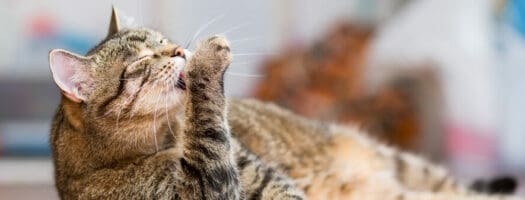3 Ways to Care for Your Long-Haired Cat
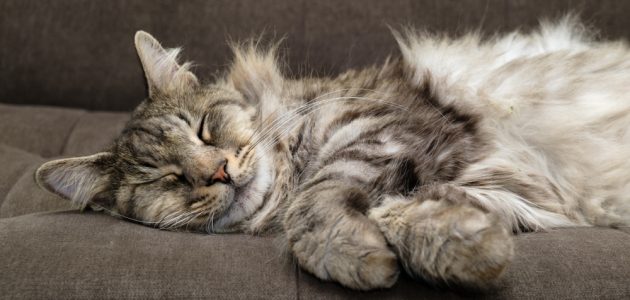
One of the best things in the world is having a purring, cuddly kitty curl up next to you. No matter whether it’s a rainy day in bed with a hot drink, or a sunny day in the garden, the loving devotion of a fluffy companion increases joy in every situation. And as the length of fur increases, so does your enjoyment of it.
Whether you are thinking about getting a long-haired cat or already own one, you should know how to properly look after your kitty. The right care will keep your cat’s gorgeous mane sleek and healthy, instead of looking like something the cat dragged in.
All cats, regardless of hair-length, have similar needs (such as a healthy diet, access to a litter box, and play-time) but long-haired cats require additional attention. Regular grooming is necessary to keep shedding and hairballs, a common issue with fluffy cats, to a minimum.
If you do have a Rapunzel-cat, focusing on three key areas – diet, grooming, and fur problems – will help you pamper your pet like the monarch it imagines itself to be.
1. Feeding Your Cat a Healthy Diet
Soft, fluffy fur starts in the stomach. That is, the nutrients your cat is receiving from its diet have a big effect on overall health which, in turn, affects the skin and fur.
Nutrients
Cats are carnivores, which means that their dietary requirements are very different from ours. They need a high-protein diet that contains fatty acids, vitamins, minerals, and amino acids like taurine. Cats cannot produce these essential nutrients themselves and so they need to come from their diet. A good brand of cat food will include all these things.
These nutrients can only be found in animal products, which is partly why your cat instinctively wants to hunt birds and mice and why Garfield loves lasagna so much. All this to say it’s a bad idea to try force your cat to eat a vegetarian or vegan diet. Without enough protein your cat will develop some serious health issues, while a well-fed cat will show its health with a beautiful glossy coat.
While these nutrients are important, you don’t need to give your cat supplements unless directed to do so by a vet. Using mix of wet and dry food will give your cat plenty of variety and all the necessary nutrients.
Wet food is a good supplementary source of water, but you should also make sure there is plenty of water available for your cat to drink. Water is an extremely important part of your cat’s needs. It aids digestions and increases the general health of your cat. Too little water can result in bowel and kidney problems.

Many cats don’t like to drink water too close to their food as it often becomes contaminated. Instead, keep a bowl of water in a separate place away from the food bowls, like in your bathroom and/or a basin of water in your yard (birdbath anyone?). It is a good idea to have at least two different sources of water for your cat so that they have plenty of options to choose from.
Hairball Control
Hairballs are caused by tangled hair ingested when your cat licks itself. The longer the fur, the more likely it is to create hairballs.
Hairballs cannot be digested and so need to come out causing gross little gifts for you to discover, usually with your feet as you stumble through to make coffee in the morning. When they don’t come out, hairballs can get stuck in your cat’s digestive tract, causing a blockage and possibly requiring surgical removal.
Brushing your cat regularly will get rid of excess hair, leaving less hair for your cat to swallow and creating fewer hairballs. You can also find “hairball control” food and treats which are specifically designed to aid digestion and help existing hairballs pass easily through the digestive tract.
2. Grooming Your Cat
While diet goes a long way toward a luxuriously soft and fluffy coat, grooming is what will take your cat to the next level of glamour. Neglecting this is a big mistake and can lead to matting which is often painful for your cat. With the right preparation and method, even the most difficult cat can be cared for. You can always hire a groomer if your cat is particularly challenging.
The frequency of grooming sessions will depend on your cat. Some cats need to be brushed once a day (or twice in some cases!), others can be groomed once or twice a month. If you don’t have the time to properly groom your cat, hire a groomer to do it for you, or consider adopting a short-haired breed.

Preparing to Groom
Preparation starts when your cat is small. Grooming your cat from a young age, even if they don’t really need it, will train them to trust you and make them more cooperative when grooming as an adult. If you adopted an older cat, you can still train them to enjoy grooming, you will just need a little more patience.
Creating a ritual around the grooming session will help your cat learn what to expect and they will be much happier and more cooperative. This ritual should include a dedicated grooming area, using the right tools and products, brushing your cat the same way each time, and lots of pets/treats.
Create a Calm Spot for Grooming
This doesn’t need to be continually set up as a grooming area or look like a full spa with candles and cucumbers, it can be as simple as using the same spot on the couch/bed or using your cat’s favorite blanket for them to sit on. The main purpose is for the cat to recognize that this is where grooming takes place, so they know what is happening.
Find the Right Time
You and your cat should both be relaxed during grooming. Loud noises, strangers and other stressors will agitate your cat and you may find it difficult to groom them without a struggle. A cat that won’t sit still is difficult to brush and you can end up hurting them if the comb or brush gets snagged in a tangle or mat.
Gather Your Tools and Products
The best tools are a wide-toothed comb, a brush, a fine-toothed comb (also called a flea comb or a defelting comb), and a slightly damp cloth. The wide-toothed comb gets all the way through the fur to the skin and is the most effective for brushing out hair from the root to prevent mats. The fine-toothed comb is best for carefully detangling mats and removing parasites, the brush smooths over the fur to make it shiny, and the damp cloth is an easy way to clean your cat and avoid a full bath. The cloth also helps to pick up any last loose hairs and wipe off dander which is a primary allergy-trigger.
Any products you use on your cat should be cat-safe as they are likely to be ingested when the cat licks itself. You can use a dry shampoo, powder, and/or a defelting spray (similar to a detangling spray for humans) to loosen mats and condition your cat’s fur, keeping it soft and smooth.
Tip: Keep all your tools and products in a basket so you can grab them quickly if your cat is in the right mood.
Once you are prepared, fetch your cat to start the grooming process.
How to Groom Your Cat
Once you’ve settled down with your cat you can start combing through its fur. It might be easiest to start from the back of the neck and down the spine. This is often a cat’s favorite place to be petted so it’s a good way to ease your cat into the session. Individual cats have different places they like to be petted though, so find your cat’s favorite spot and go from there.
Start by using the wide-toothed comb. This gets through the fur all the way to the skin, untangling fur right from the root. If you only use a brush, you may find that your cat’s fur creates mats more often than when you use the comb.
While combing, focus on areas that get a lot of movement and friction as this is where the most mats are created. These areas include the armpits, under the chin, behind the ears, the belly, and the back legs. Be careful when combing around the belly as this is an area your cat will be very protective over and you might get needled like a toy in a claw machine.
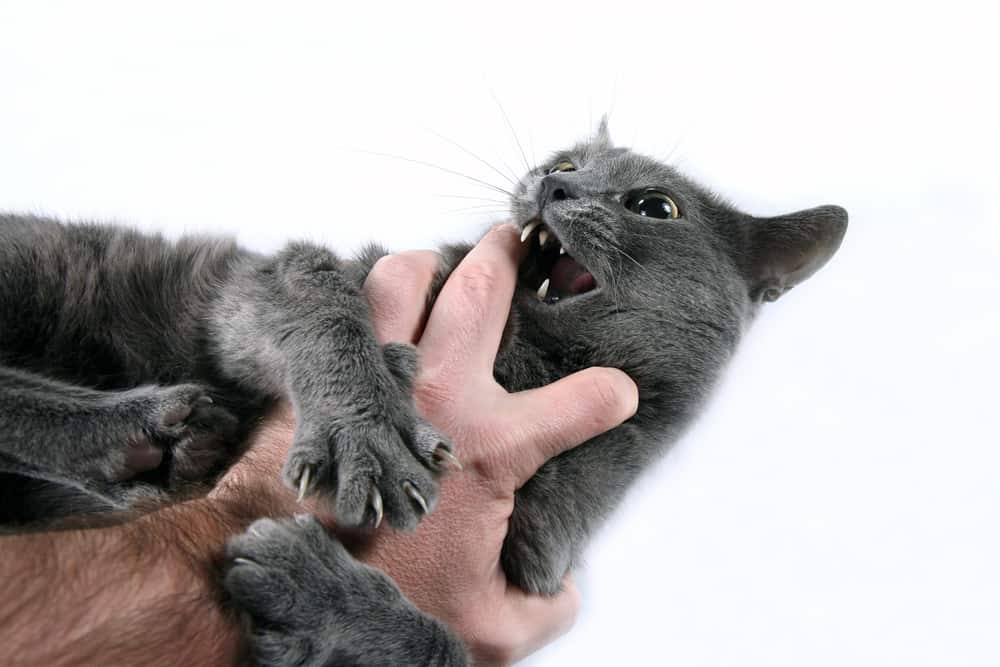
Tip: Build up trust with your cat by watching its body language and stopping when your cat is getting agitated.
If you do find a mat, use the fine-toothed comb to tease it out. Mats pull at the skin which can be painful for your cat so it’s important to be gentle. Applying some cat-safe powder will help with stubborn mats as it absorbs some of the oil holding the mat together. If the mat cannot be brushed out, you might need to cut it off. Use scissors with a rounded tip to avoid cutting your cat accidentally. In severe cases, take your cat to a groomer as they will have the best methods and equipment to deal with the mats.
Another area to focus on is on the back legs and under the tail. Long haired cats often struggle to stay clean after using the litterbox and things get stuck to the fur. This can be easily cleaned with a damp cloth and brushed out with a comb.
Some breeds like Persians and Himalayans need extra attention around the eyes as residue tends to build up and stain the fur. Wipe this area gently with a damp cloth to clean it.
After combing, if your cat is happy to continue, go over the fur again with the bristled brush. This will smooth it out making your cat look glossy and fabulous. At this stage you can also use a product like dry shampoo to add some extra shine to your cat’s fur.
Tip: With every grooming session, give your cat lots of praise, pets, and treats. This will encourage positive emotions toward what you are doing and as time passes your cat will learn to love the attention they get during your grooming sessions.
Bathing Your Cat
Cats self-clean and therefore don’t need to be bathed, although occasionally it is necessary to do so. Bathing is stressful for most cats and should be kept to a minimum. If your cat is very dirty with mud, diarrhea, or something toxic, a bath is the best and easiest way to clean it, but if a full bath is too stressful for your cat you can clean it with warm water and a cloth.
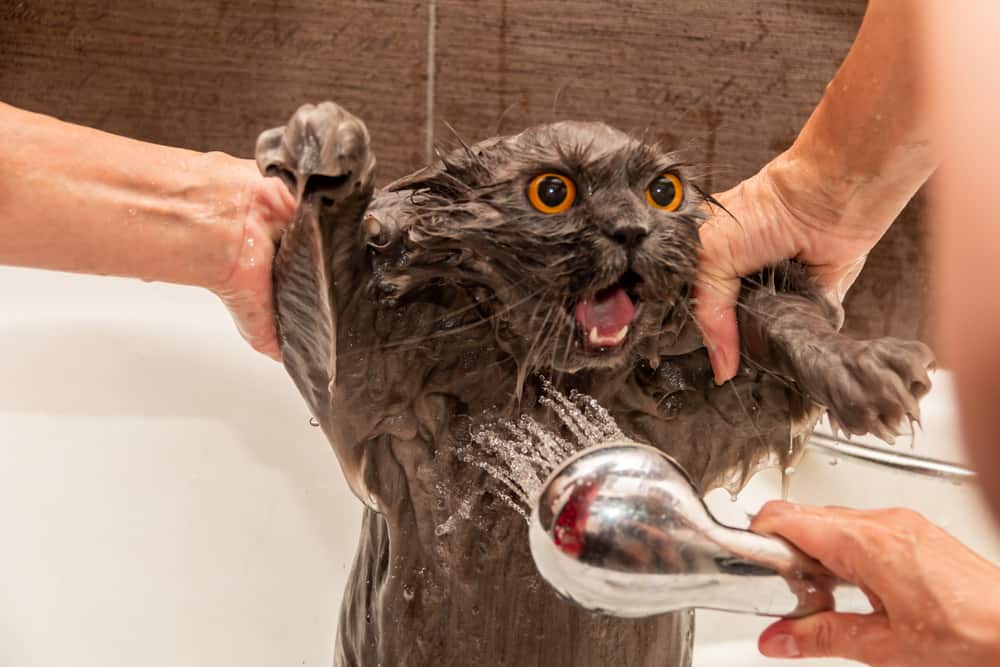
If your cat is prone to matting, a bath can help lessen this. Overproduction of the natural oils from your cat’s skin clumps the hair together, causing mats to form. Cleaning your cat with a cat-safe shampoo can help keep these oils under control.
Baths shouldn’t be given too often, though, as they can strip the natural oils from your cat’s fur and skin, drying it out and causing problems like dandruff. Once a month or so should be enough to keep oil production and matting under control, although it’s best to consult a groomer about your cat’s individual needs.
A bath can also be a good way to deal with severe flea infestations. Using a flea shampoo for cats will kill the fleas and stop their breeding cycle. Just be sure to also clean your home and any areas your cat might pick up more fleas.
If you do bath your cat, try to schedule it on a warm day as cats can get sick if they get cold. Run a few inches of lukewarm water in a large basin or bath. The sound of running water will stress them out so having the water already run will help lessen the stress. Ask someone else to lend a hand if they can, have some dry towels handy for afterward, and make sure to don your protective gear before you fetch your cat.
Use a cup to pour water gently over your cat before rubbing in the cat shampoo. Talk to them reassuringly, giving them lots of praise and pets to help them stay calm. Once you have rinsed off the shampoo, firmly stroke your cat to get rid of excess water before wrapping them in a towel like a cozy “purrito.”
Dry your cat as much as possible with the towel. If you can, use a hairdryer to make sure the cat is completely dry so they don’t get cold. If you can’t, because the cat is too stressed and you can see the beginning stages of PTSD, provide them with a warm place to dry off naturally.
3. Problem Solving Bad Hair Days
We all experience bad-hair days and cats are no different. Long-haired cats are particularly prone to issues like matting and excess shedding, which are usually fairly easily solved with regular grooming.
However, as you are grooming your cat, you might notice some other issues affecting the quality of your cat’s fur. Listed here are some common problems and how you can deal with them, but if you are unsure, take your cat to the vet as they will have the best advice.
Shedding
Like humans, all cats naturally lose hair over the course of the year. This increases during seasons of change like spring and fall as your cat’s coat changes in preparation for hot or cold weather. Shedding is accentuated with long-haired cats as long hair is more noticeable than short hair when shed.
While you should be brushing your cat regularly, you should increase the frequency of your grooming sessions during these seasons to keep the shedding under control, otherwise you could end up with more dust-bunnies than cats.
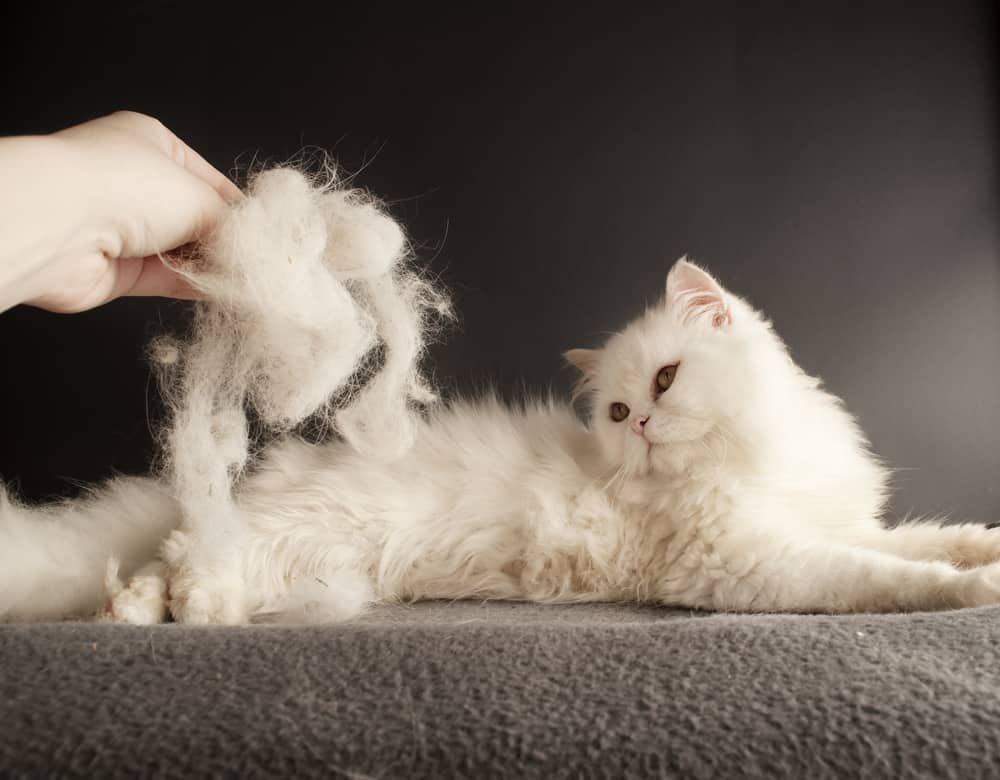
If your cat is losing hair in big clumps or to the point of creating bald spots, there is a bigger issue and you need to consult a vet. Hair loss on this scale can be attributed to stress, parasites, metabolic disorders, or autoimmune diseases. A vet will be able to diagnose and help you treat these issues.
Stress
Cats, like people, can be mentally or physically stressed. Mental stress is often caused by distressing situations like moving to a new home, traveling, introducing a new pet, or other environmental changes. Illnesses, surgery, or pregnancy are physical stressors that can also affect your cat.
This stress can result in hair loss and bald spots on your long-haired cat. Sometimes these situations are unavoidable and just knowing the probable cause can help you deal with your own stress about the situation. Where possible, try to reduce the stress to your cat.
Ask your vet about using mild sedatives before traveling and learn how to introduce a new dog or cat in the least stressful way. Just don’t subject your pets to one of those awkward getting-to-know-you teambuilding games that we all know and hate.
Matting
Matting or tangling is only a problem in long- and medium-haired cats. As they walk, the cat’s fur gets knotted up, especially in areas where there is a lot of movement like the armpits, belly, behind the ears, and under the chin. These knots, along with oils from the cat’s skin, prevent natural shedding from occurring and the “dead” hair creates a mat. You might enjoy Bob Marley’s music, but your cat probably isn’t interested in impersonating him.
These mats can hurt your cat if they get too big as they pull on the fur. In severe cases, the mats get really heavy and will need to be carefully shaved off. You will need to take your cat to the vet or a licensed groomer for this as it is often necessary for the cat to be anesthetized for this procedure. If you try to do it by yourself, you are likely to hurt the cat (and yourself) as it will not be willing to stand still while you cut/shave it.
To avoid this issue, stick to a regular grooming schedule so that excess fur is removed before it can mat, and small mats can be brushed out before they become a more serious issue.
Parasites and Skin Conditions
Fleas, ticks, mites, and bird lice are common external parasites you might find on your cat, especially if it is allowed outdoors. Other parasites and skin conditions include tapeworms and ringworm. If left untreated, these nasties can cause uncomfortable skin problems for your cat, and in severe cases can infect your cat with more serious diseases.
While grooming your cat, keep a lookout for any rough patches of skin and signs of fleas or ticks. Fleas and ticks can be removed manually but it is a good idea to use a flea collar, spot treatment, and/or bathe your cat using a flea shampoo for cats. Your vet will also have tablets or medication to control other parasites like worms that they administer when you take your pet for its vaccinations.
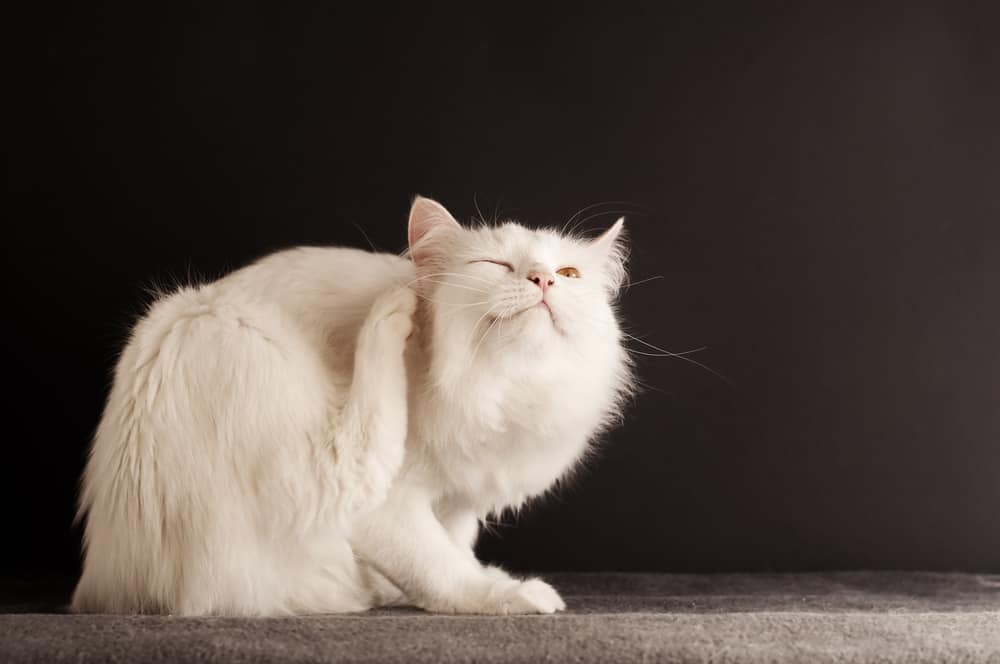
If the flea or tick infestation is particularly bad, consult your vet about treatment and see if there are areas in or around your house and yard where your cat could be picking them up. Ticks and fleas like long grass, so cutting your grass regularly should minimize the number your cat can pick up. Fleas often reproduce in carpets, pet beds, and sand. Once you have identified where the fleas are breeding, you can get rid of them. One method is regular vacuuming combined with a flea powder or spray to bring them under control.
If your cat is picking up parasites from a particular area, try to keep them away from that area until you can kill the parasites and be sure it’s safe.
No Need to Tear Your Hair Out
As you can see, caring for your long-haired cat, while a bit more work than caring for a short-haired cat, isn’t complicated; it’s just time-consuming.
To sum up, there are three main ways to care for your long-haired cat:
- Condition the fur through its diet and ensuring it gets the right nutrients and enough water,
- Regularly groom your cat to prevent matting and keep the fur soft and fluffy,
- Identify issues before they become serious so you can make sure your cat stays healthy.
Doing these three things will ensure your cat is a cut above the rest, looking their best and making your friends jealous that you have such a beautifully soft and fluffy kitty.

